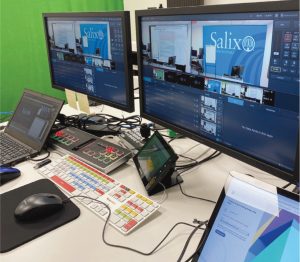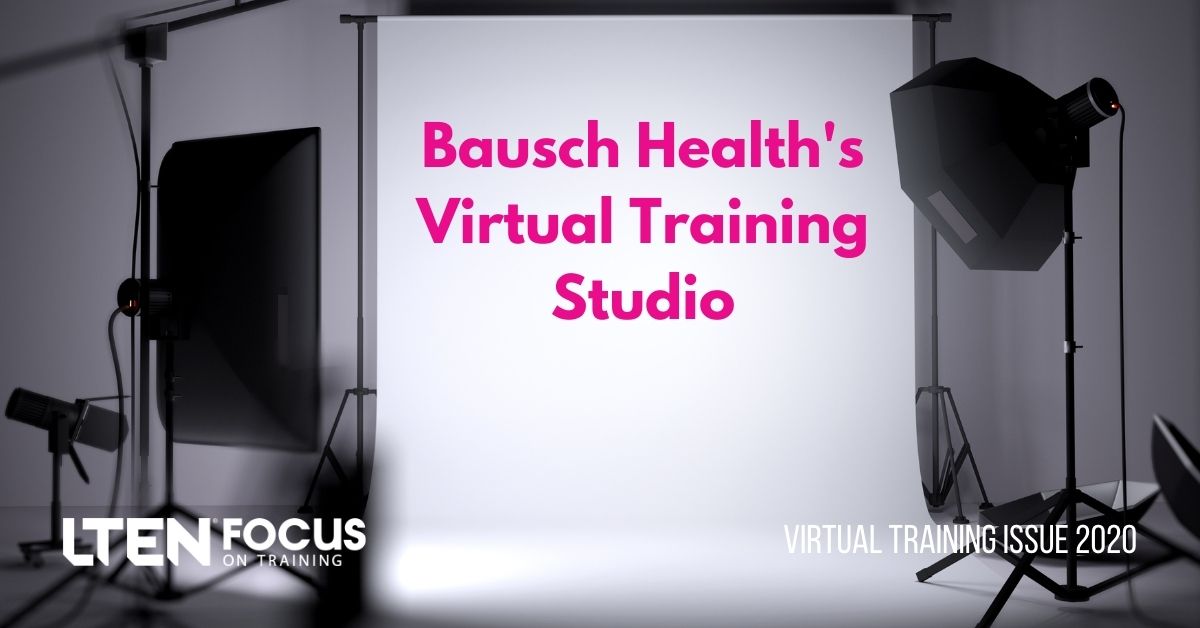
Bausch Health’s Virtual Training Studio
FEATURE STORY – By Dave Huston
The need for a distance learning platform was evident, coupled with the need for a dedicated space to facilitate these virtual events.
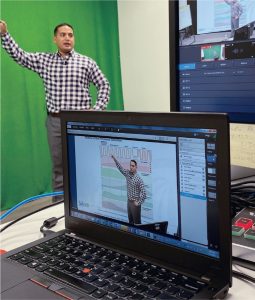
Pete Scalici, a Salix training manager, delivers virtual training from Bausch Health’s studio.
Recently, Bausch Health’s learning & development (L&D) team identified the need to
augment its training offerings to include an engaging distance learning initiative. As a result, a brand new state-of-the-art virtual training studio was born, and although now functional, the road to success is never easy.
Internal stakeholders occasionally make requests of the commercial learning & development team to schedule training time with new hires during their live initial instructor-led training (ILT) classes at corporate headquarters. This makes sense given the effectiveness of in-person ILT, but also comes at a high cost.
Since each business strives to achieve the shortest possible time-to-proficiency post-hire to maximize return, ILT agendas are ultimately influenced by business priority. Typically, the first priority is to ensure the organization has provided training that reduces the opportunity for any high-risk behavior or potential litigation against the organization. Productrelated promotional activities are then reserved for the majority of live ILT.
Many lower risk, albeit important, training items are subject to a lesser priority or format, which sometimes results in shallow or undetermined knowledge retention. These formats include, but are not limited to, minimally interactive e-learning modules, flat PDF documents, quick reference cards or, in some cases, nothing at all. Clearly, the need for a distance learning platform was evident, coupled with the need for a dedicated space to facilitate these virtual instructor led training (VILT) events.
Supporting Virtual Needs
Bausch Health’s new in-house L&D A/V Studio was intended to support the virtual learning needs for all North America commercial sales teams, comprised of more than 1,800 remote sales professionals. Since multiple initiatives in pursuit of Bausch Health’s business objectives were well underway, space at 400 Somerset Corporate Circle in Bridgewater, N.J., was in short supply — especially on the second floor, which holds the larger classrooms. To avoid competing with this limited real estate, Site Services offered to forgo one of their storage rooms to allow for the creation of a dedicated virtual training room.
Once remodeled, this in-house studio would eventually enable learning & development and the greater organization to produce a variety of distance learning formats, as well as stream or record live audio and video with little overhead, using some of the most technologically advanced software available. With the partnership of Facilities, IT, Shipping, Security and outside vendors, we transformed a dusty 14-by-20-foot storage room into a bright and beautiful space.
The new space would enable team members to record audio for podcasts or stream/record live video. Features include a dedicated phone line, ceiling speakers and LiveStream software. The physical layout could accommodate a five-person panel within the green-screen backdrop, and the software provides for hosting highly customized, interactive sessions featuring a virtually unlimited number of creative possibilities, such as customized graphics, video layering, timed animations, picture-in-picture, a graphics store and much more.
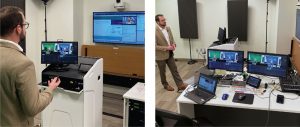
Kevin Audette, a Salix training manager at Bausch Health, demonstrates how the Adobe Connect platform helps make the audience visible to the presenter.
Self-Producing Sessions
We had no intention of budgeting for a full-time production assistant or contracting with a production team each time a podcast or VILT session was produced. As a result, the equipment and software needed to be easy enough to understand and operate to enable a training team member to self-produce sessions, or at the very least succeed with the help of a colleague. We ultimately ended up using the Adobe Connect platform with licenses for our training leads. The Adobe platform’s features were more than sufficient to match our training needs. Persistent rooms using a single and recyclable URL, widescreen HD-quality video images, polls and other formative feedback mechanisms, customized layouts, breakout sessions, whiteboarding, gaming and more all allowed Bausch Health to closely simulate the experience of a live ILT event, further maximizing engagement and knowledge retention.
After funding was approved, we entertained three supplier designs, conducted a cost analysis, selected the partner, began construction on remodeling, installed equipment, established processes and trained the internal team, with the estimated completion set at six to nine months. However, some of the challenges we encountered resulted in overall delays, one of which was the slightly mismatched compatibility of Adobe’s technology roadmap with the timing of the roll-out of specific devices (iPad/laptop/surface).
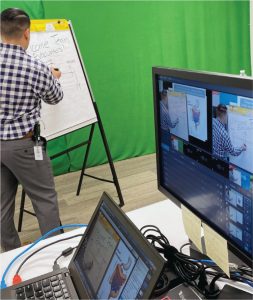
The wall-mounted HD camera lets trainers use “old-school” tools along with the high-tech to engage the audience in many ways.
To overcome this, we needed to generate multiple sets of host and learner guides to ensure the successful operation for both iOS and Windows operating systems. We also encountered some internal delays in establishing the VOIP phone line in the studio since the primary IT contact was located out of a different hub. We enlisted help from our local deskside support team to resolve the distance issue. Finally, we were posed with the challenge of integrating the output of the LiveStream software as a camera input for the VILT platform (Adobe Connect Classroom). For this, we connected the two using a video capture device to synergize all the studio’s features for a VILT experience like no other!
Delivering Value
At Bausch Health, the learning & development team monitors the delivery of a return on expectations to our internal stakeholders and strives toward a return on investment. Not only do we anticipate significant savings from this project, but this also advances the opportunity for leadership to execute frequent and engaging two-way communication (or training) with our remote teams on short notice. We will be comparing the new VILT program content against those for which we have baseline L&D scorecards from 2018 and 2019 to assess cost savings of migrating these scheduled ILT courses to a virtual format. We expect to realize significant short- and long-term cost savings (e.g., hotel, travel, time out of role, etc.) after our assessment is complete in Q4 of 2020.
Certainly, the benefit of having the option to communicate with any segment of the organization, at any time, for any reason reaches beyond simple convenience. As an example, a brilliant use case for HR has already been slated for production in 2020, as they plan for the roll-out of “A Path to Coaching Proficiency,” a series of live interactive sessions with the field leadership teams.
Key Questions
Regardless of your own specific intentions, before you begin, here are some questions to ask yourself:
- For what size team are you looking to create this resource? This will help determine if you need to consider one (or more) and dedicated room(s) and camera(s), if competing for the schedule becomes cumbersome. What size audience are you looking to reach and what equipment are they using?
- This will help determine both the type of platform features, the number of licenses you consider for each team member and compatibility between the audience’s equipment and the VILT platform (both now and in the near future).What content will your team be covering?
- Although it may seem obvious, not all training is ideal for a virtual format. For example, due to the limited real estate on the screen, technical training (such as learning a new analytics platform) may require a learner to use a portion of their own screen to follow along, something that may be better suited for live instruction.
- In what sequence will this training be assigned? Another obvious example, nonetheless, might be to schedule a virtual training session on how to set up your new company laptop when the laptop itself is a prerequisite.
- What might your budget allow? There are a variety of low- to medium-cost options available depending on what levers you may be attempting to pull. For example, if an HD camera with remote zoom, pan and tilt is not an option, the net result of a more engaged audience may still be possible using an integrated camera, or even an inexpensive plug-in, so long as one considers camera angle, lighting, background, audio connection, gamification and VILT platform skills, among others. What other functions might benefit from a dedicated virtual training studio?
- As mentioned earlier, many stakeholders may approach L&D for live training time within their agenda. If select stakeholders are interested in utilizing such a resource, their commitment may help fund or possibly justify a charge-back model to procure the needed funding. For example, sales leadership may find such a resource aligns with their overall communication initiatives. Or, perhaps Quality or Compliance may wish to reach their audiences with a more interactive experience as opposed to a one-directional PowerPoint presentation.
Dave Huston is senior manager, commercial learning & development, for Bausch Health. Email Dave at Dave.Huston@BauschHealth.com.
Fall 2020

